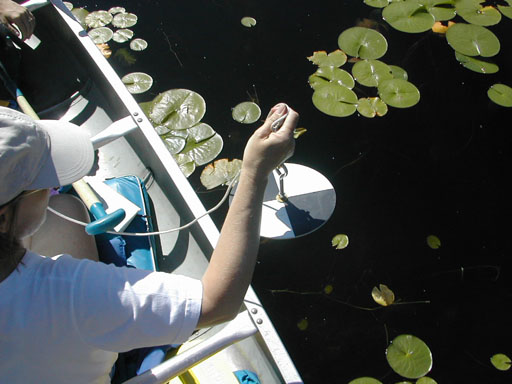
One measure of the quality of the water in lakes, rivers, and streams is the total amount of solids dissolved in the water. High amounts of dissolved solids can indicate poor water quality. The same is true for drinking water.
In the photo, the person is using a Secchi disc to check the turbidity (cloudiness) of the water. They will lower the disk into the water until they can no longer see the difference between the black and white quarters.
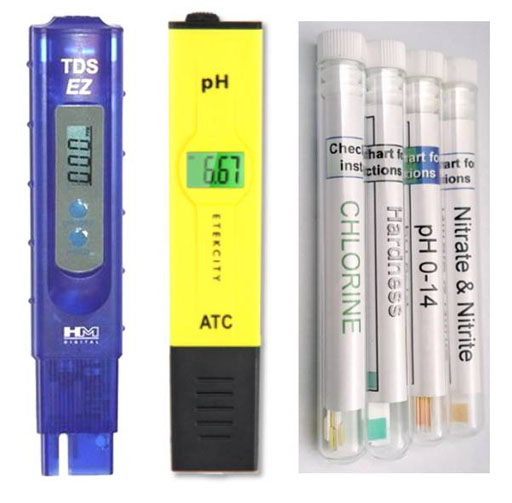
You will need the TDS meter, the pH meter, and test strips for Chlorine, Hardness, and Nitrate/Nitrite. You don't need the 0-14 pH strips shown.
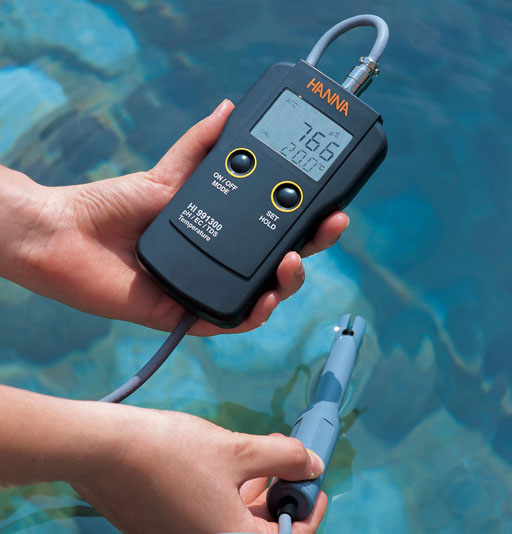
Objective 1: Learn the meaning, applications, and measurement techniques for "total dissolved solids" (TDS). Also use the TDS meter to test the TDS levels in various beverages.
Basic Meaning: "Total Dissolved Solids (TDS)" is the concentration of the dissolved chemicals in a sample of water. Before dissolving, these chemicals could have been a solid or a liquid.
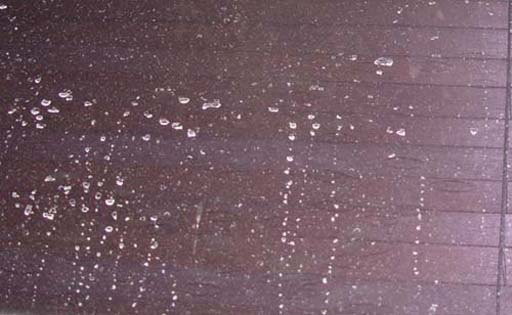
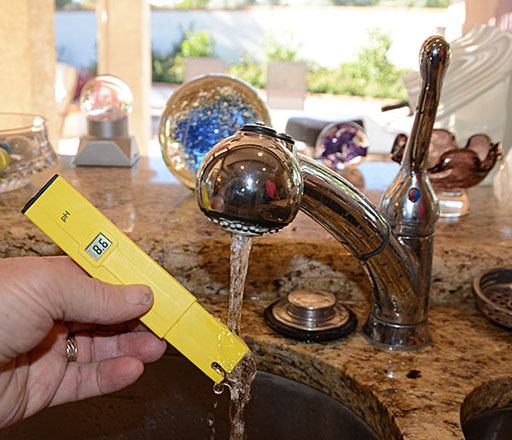
Objective 2: Learn the meaning of pH and the value of knowing the pH of items. Also use pH meter to determine pH of your tap water and various beverages.
The pH meter makes it easy to test the acid concentration in various liquids.
This photo is not showing the measurement of pH of tap water. It's showing the pH meter getting rinsed off after being placed in some other liquid.
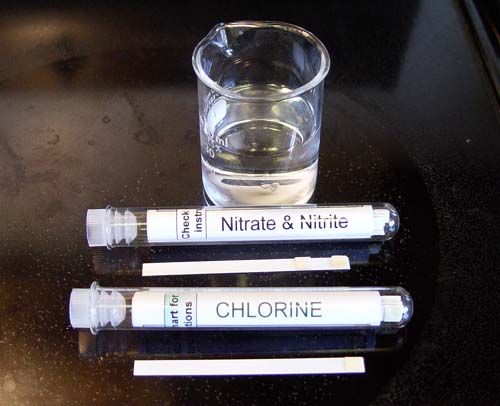
Objective 3: Use test strips to determine water quality properties of your tap water. Also learn the value of testing for chlorine, nitrate, nitrate, and hardness.
There is a wide variety of test strips to test different chemicals in water. In this lab you will be using three of the most common ones.

River, lake, and stream testing.
Pure water has nothing dissolved in it. So pure water has zero total dissolved solids. However, when minerals, salts, and pollutants dissolve in water, then the total amount of these dissolved solids gives an indication of the water's quality. The Environmental Protection Agency, for example, would measure total dissolved solids (TDS) in lakes, rivers, and streams to monitor water quality.

Swimming pool and spa maintenance.
High TDS indicates hard water, meaning there are a lot of dissolved minerals that will form scale (white crusty mineral deposits made mostly of calcium carbonate) on the sides of the swimming pool or spa and the insides of pipes. Monitoring TDS can allow intervention before scale forms.
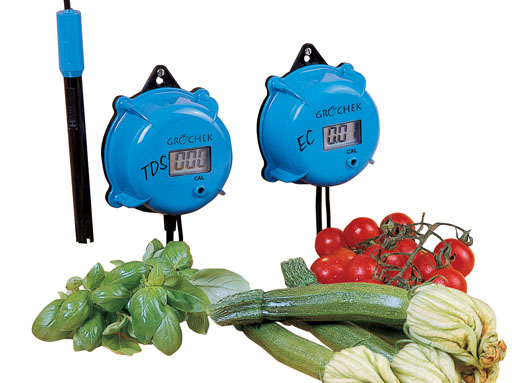
Agriculture and hydroponics (hydroponics is the science of growing plants without soil).
Moisture in soil that has high salt levels will not move into the plants' roots, causing drought symptoms even when there is plenty of water present. A TDS meter can see if the water for the plants is too salty.
Using a meter that measures TDS is also useful in keeping track of the level of nutrients in the water. Most of the nutrients for plants increase the TDS levels (more nutrients are dissolved). So in these cases, a high TDS level indicates plenty of nutrients are present. This meter can also check the quality of water that is being brought in to water the plants. In looking at water coming in, high TDS might indicate too many minerals (hard water). So the grower may want to lower the TDS by removing the excess minerals before adding nutrients.
The TDS meter is on the left. An electrical conductivity (EC) meter is on the right. The EC meter is basically measuring the same thing but reports values using different units of measurement.

Aquarium maintenance
TDS (total dissolved solids) is a measurement that can help track the levels of dissolved waste and dissolved minerals. When TDS levels are too high, the aquarium water is pumped through various filters to remove the dissolved waste and dissolved minerals. These filters are often reverse osmosis membranes that allow water to pass but little of anything else.
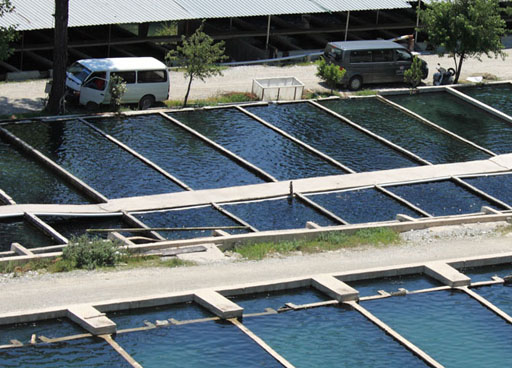
Aquaculture
Aquaculture is the farming of fish, oysters, or seaweed in controlled environments.
TDS levels are monitored because high levels of TDS can kill young fish.
![reverse osmosis plant]](reverseOsmosis2.jpg)
Water treatment plants and home water use
Water that has high TDS values will taste salty, metallic, or bitter. The Environmental Protection Agency (EPA) sets the maximum level of total dissolved solids for drinking water to be 500 milligrams (half a gram) of dissolved solids for every liter of water.
These dissolved solids are removed using reverse osmosis membranes. As mentioned earlier these membranes allow water to pass through but block large atoms, larger compounds, and microscopic particles that make up dissolved solids. These membranes also block toxic metals and other toxic substances.
Reverse osmosis systems are used in the home, water plants, and at places that dispense drinking water (usually at 25 cents a gallon)
Source and make up of dissolved solids

Rain water has no dissolved solids. So it has zero TDS. However, when it contacts the ground, the rain will dissolve fertilizers, salts and minerals, animal waste, pesticides, plus other chemicals that may be on the ground from cars and industrial pollution. Even decaying plants have chemicals that get dissolved. Water can also pickup more solids as it passes through copper pipes. So these dissolved solids can be a multitude of chemicals.
The most common chemicals counted in TDS tests are salts like sodium chloride (table salt), calcium chloride (salt placed on icy roads) and fertilizers like ammonium nitrate, various phosphates, and various potassium salts (potassium carbonate, potassium chloride, potassium sulfate). There are also dissolved minerals like calcium carbonate (limestone) or magnesium carbonate and calcium sulfate (gypsum/drywall material) or magnesium sulfate (Epsom salts).
There are thousands of other chemicals in our water, but TDS looks at all of them as one group (one reading).
How is TDS measured?
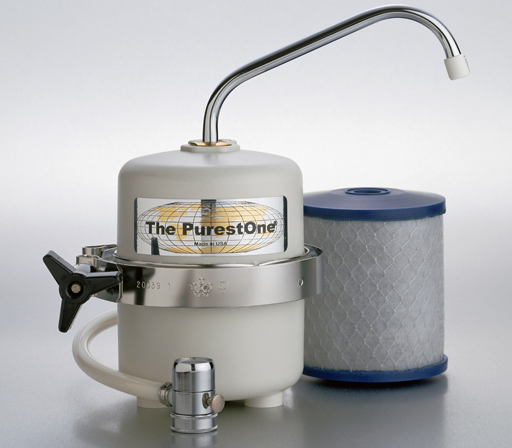
Gravimetric method: To measure TDS using this method, the water sample is first passed through a filter that blocks anything bigger than 2 microns ( 2 micrometers or 2 millionths of a meter). This ensures the test measures dissolved solids not solids suspended in the water. Such things as sediment or specks of plant material are filtered out and therefore not counted in the "total dissolved solids".
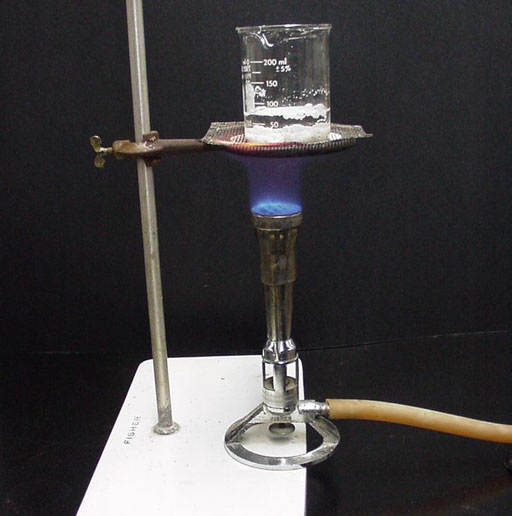
Gravimetric method continued: A certain amount of the filtered water is then weighed out and the water is boiled away leaving the dissolved solids behind as a solid residue. This residue is weighed. This is called the gravimetric method because a balance is used. Balances need gravity to find the mass. So that's why it's called a gravimetric method.
This method was used in the online CHM130 labs but won't be used for this CHM107 field lab.
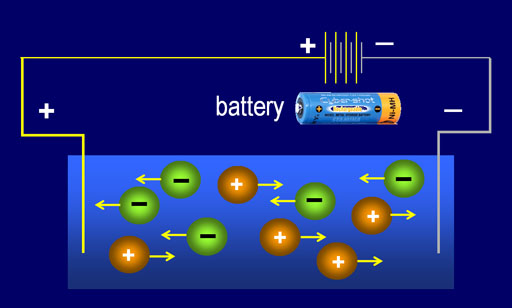
Electrical Conductance Method: The other way TDS is tested is by measuring how well the water sample conducts electricity. If the dissolved solids are salts and minerals, they would have dissolved (disassociated) into plus and minus ions. This allows electricity to pass through the water. For example, sodium chloride (NaCl) becomes Na+ and Cl- when dissolved in water. The negative chloride ions (Cl-) will be attracted to the + side of the battery terminal to give up their electrons, and the positive sodium ions (Na+) will be attracted to the negative terminal to pick up electrons. In this manner, the ions will allow electrical current to pass through the water. The more electrical current flows through the solution if there are more ions in the solution. More ions mean there are more dissolved solids, so TDS goes up.
Electrical conductance is the measurement of how much a material (liquid, solid, or gas) conducts electricity.
Electrical Conductance Method: Measuring electrical conductance with a meter is a quick way to get a measurement of the total dissolved solids. There are two meters of this type. There is an electrical conductance meter (EC meter) and a TDS meter.
The electrical conductance method does miss chemicals like sugar, alcohol, and antifreeze. These chemicals do not form ions and therefore do not help conduct electricity, so they aren't measured using one of either of these meters; however, chemicals like these can be measured using the gravimetric method by weighing the water sample before, during, and after the water is boiled away.
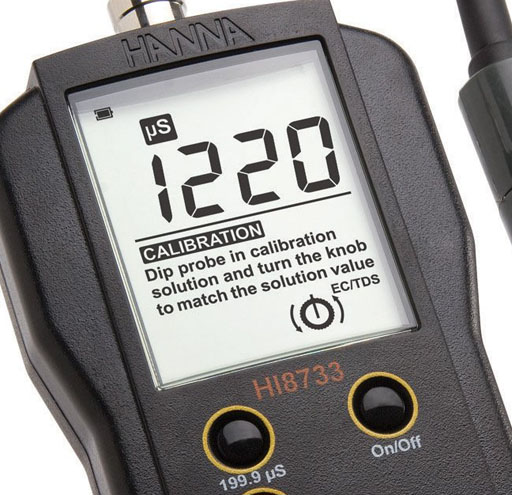
The EC meter (electrical conductivity meter) measures in siemens (named after German inventor Ernst Siemens). On this meter the readout is 1220 and notice the unit is µS, which means microsiemens (one millionth of a siemens).
Siemens is directly related to the total dissolved solids. Using a calibration solution, these meters can be adjusted to read the proper electrical conductance (in siemens) or the proper TDS (total dissolved solids measured in parts per million or milligrams per liter).
A TDS meter is actually an electrical conductivity meter (EC meter) that calculates TDS from the siemens value and reports the TDS concentration in mg/L. That's why you see meters that are dual TDS and EC meters.
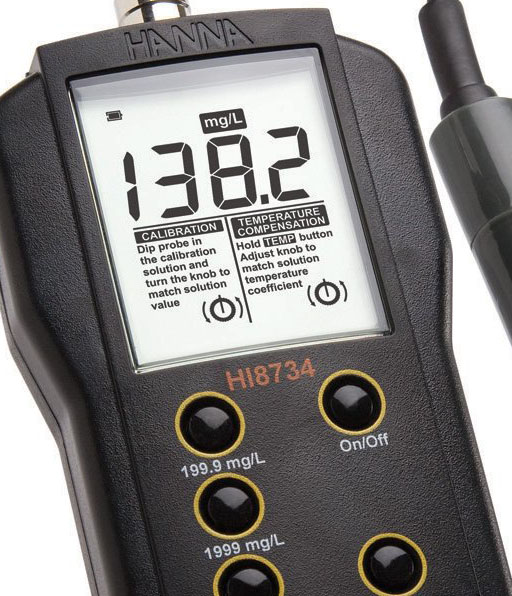
Here are the concentrations written as fractions. The fraction bar is the "per".
parts = grams ÷ 1000 = milligrams = milligrams
million 1,000,000 grams ÷ 1000 1,000 grams Liter
The math shows us going from the generic "parts per million" to a more specific "grams per million grams." This is reduced by dividing numerator and denominator by 1000 to get milligrams per 1,000 grams. Knowing that a liter of water weighs 1000 grams, "Liter" replaces the 1,000 grams. So if you are given the concentration of total dissolved solids as 435 ppm, you can change that to 435 milligrams per Liter.
1. Once a solid is dissolved in water, is it still solid?
2. If sugar is dissolved in water, does it get measured using a TDS meter?
3. If sugar is dissolved in water, does it get measured using the gravimetric method for finding total dissolved solids?
4. If snow was melted and tested with a TDS meter, what level would you think it has?
5. If you take tap water and make ice cubes with it, does the TDS level change and why?
6. Would a bottling company like Coca-cola do TDS testing? (Why or why not?)
7. If a full glass of tap water sat outside in the sun for few days and half of the water evaporated, does the water in the glass now have higher, lower, or the same TDS level as the water when the glass was full?
8. Sodium nitrate is a common fertilizer. In water, this solid disassociates into Na+ and NO3-. Will these ions reduce or raise electrical conductance in water?
9. Which would have a higher TDS reading, water from a freshwater lake or water from the ocean?
(answers are at the very end of this lab).
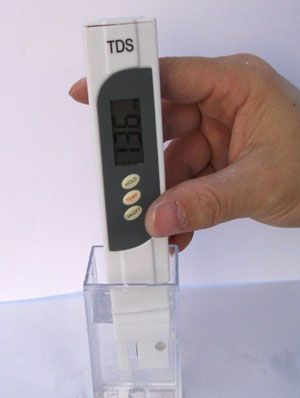
TDS meters are popular because they are easy to use. There's just a few things to keep in mind in order to get accurate readings.

This is the TDS meter which is in the carrying bag in your lab drawer. The readout screen shows TDS in parts per million. Note, that the same numbers can also be read as milligrams per liter.
The top blue button turns on the meter. Use the same button to turn it off. If left on too long, the meter will turn itself off.
The bottom blue button freezes the readout so that you can remove the meter from the water and the readout doesn't change.
The meter needs to be submerged between the green line and the red line. Do NOT submerge the meter any lower in the water than where the red line is. The TDS meter is not water-proof.
The solution needs to cover the metal posts that measure the conductivity. If the meter is dipped to the green line, then the metal posts are covered.
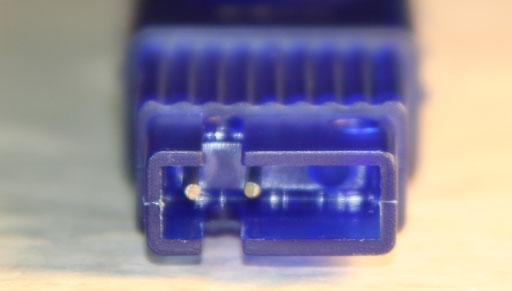
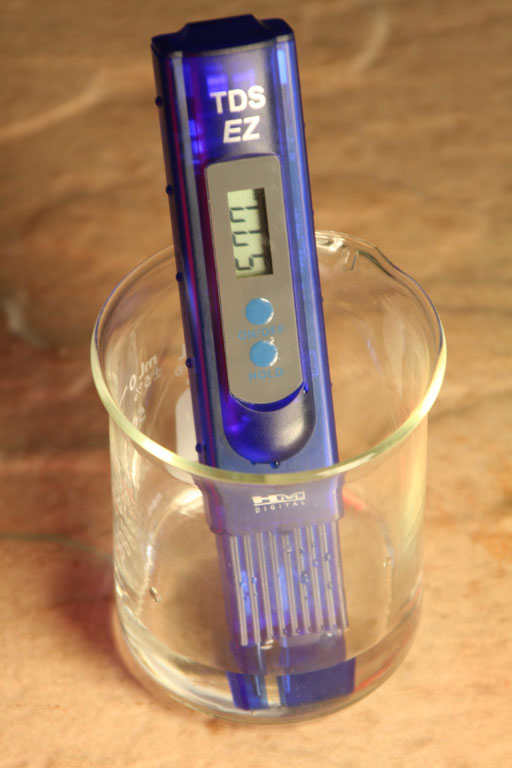
To take a reading, simply dip the probes into the water being measured. Stir meter gently so that any bubbles clinging to the metal posts are dislodged. If you can see the screen, then you can get the reading for Total Dissolved Solids. If it's hard to see the screen, press the lower blue button once to freeze the reading on the screen, then bring the meter up close to you to read the screen.

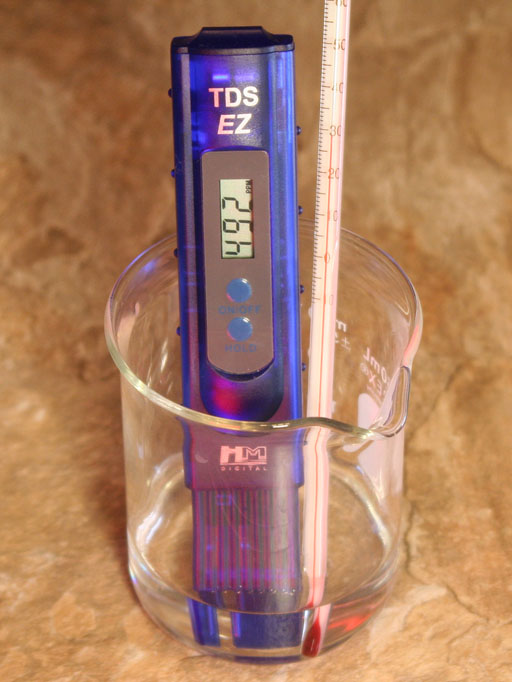
The first thing to test is your tap water.
1) Place tap water from the cold water side into a container so that the water is between the proper level on the TDS meter as shown above. This picture includes a thermometer. With some TDS meters, you need to measure the water temperature to make the reading a little more accurate especially for hot and cold liquids. This was done for CHM130, but you don't need to do that for this CHM107 field lab.
A1) Report the TDS value that you read off of your meter.
A2) Compare the reading you got with the readings in the below chart. What category does your tap water fall into?
|
|
|
|
|
|
|
|
|
|
|
|
|
|
|
|

2) Now check the TDS level of a beverage like a soda, juice, tea, coffee, or beer.
Again, you don't need to use a thermometer with your TDS meter as seen in this photo.
Warning: If you choose a carbonated beverage, you will probably notice the readings jumping up and down. What do you think would cause that?


If your beverage was cold, you will notice the TDS values going up as the liquid temperature goes up. That doesn't mean the TDS values are changing because the dissolved solids in the beverage are not changing. It just means the TDS meter shows a more accurate reading as the temperature gets closer to room temperature. Some TDS meters automatically adjust for temperature, so the TDS reading should stay steady even if the liquid warms up or cools off.
A3) Report what beverage you used and its TDS level.

pH is a term that is placed on a lot of product labels, but most people really don't know what it means. They usually figure it has something to do with how acidic something is, which is correct. "pH Balanced" is another term that is thrown about, but also poorly misunderstood.

Going from a pH to H+ concentration is easy. Just make the pH number negative and make it the exponent of 10. The pH values in the image below will then turn into this list: 100, 10-1, 10-2, 10-3, 10-4, 10-5, 10-6, 10-7, 10-8, 10-9, 10-10, 10-11, 10-12, 10-13, 10-14 moles per liter.
Note 100 = 1 mole per liter. Also note, as the pH number goes higher, the concentration of H+ is gets smaller. That's because these negative exponents indicate that the 10 is actually in the denominator. For example, 10-6 is the same as 1/106, which is one over a million, or one millionth. Again, the H+ concentration is smaller with high pH numbers and greater when the pH number gets smaller. So it's just the reverse of what you might think.
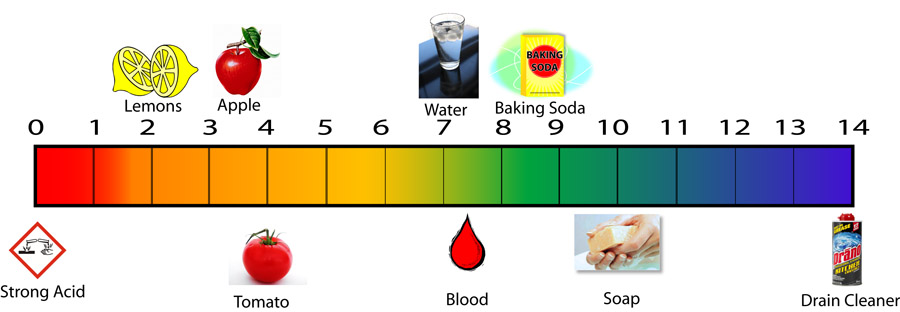
100, 10-1, 10-2, 10-3, 10-4, 10-5, 10-6, 10-7, 10-8, 10-9, 10-10, 10-11, 10-12, 10-13, 10-14 moles per liter.
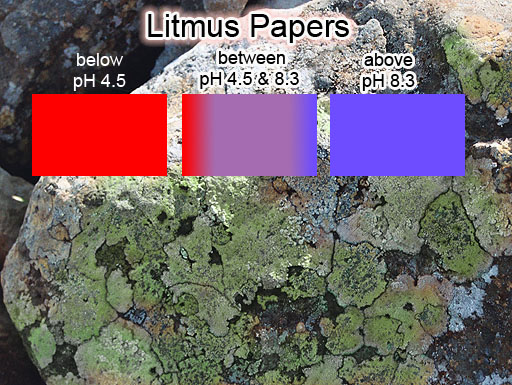
LITMUS PAPERS: Litmus paper is usually made from about 10 to 15 dyes that are extracted from lichen (a fungus). In the desert we often see rocks with lichen on the shady side of the rock. It's usually green but can also be other colors. The dyes turn blue if in alkaline solutions. However, when in acidic solutions, the dye turns to a red color. So blue litmus paper turns red if the solution is moderately to highly acidic (pH<4.5). Red litmus paper turns blue if in an alkaline solution (pH>8.3). In between these pH levels it is purple.
The word "Litmus" is from an Norwegian word, "Litmos". "Lit" means "light" or "colored" and "mos" means "moss", a plant similar to lichen.
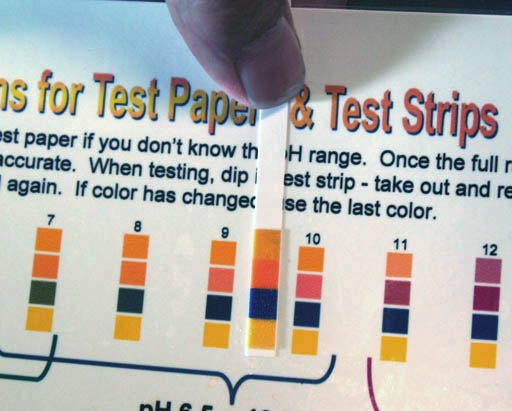
Universal pH Paper: To the left is a typical universal pH paper that measures the "full" pH range of "1 to 14" or "0 to 14". This paper usually has 4 squares to indicate the color. Each square has a different dye because different dyes will change colors over different ranges of pH. You match the 4 colors with the closest 4 colors on the pH chart that comes with the pH paper.



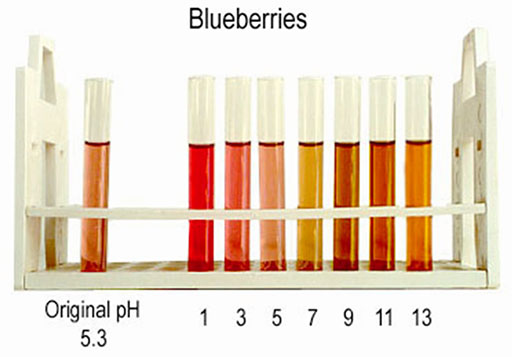
BLUEBERRY EXTRACT: To the left are colors of blueberry extract (blueberry juice) at different pH levels. Notice that natural blueberry juice has a pH of about 5.3 (slightly acidic). At more acidic levels is it more red. At alkaline pH it is more brown. As you can see the color change isn't as dramatic as it is for red cabbage extracts.
Extracts from red grapes, apple skins, other colored fruit and vegetables will change their colors depending on the pH. Making an extract can be done by chopping or grinding the plant, then boiling it in water or soaking it in a solvent like acetone. Either way, this extracts the colored pigments.
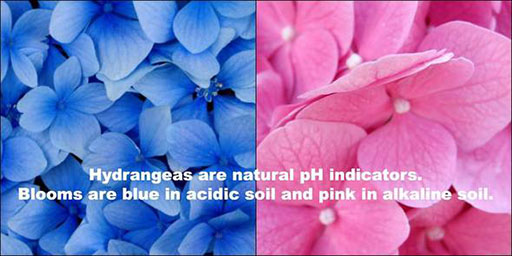

The old favorite poem starter "Roses are Red, Violets are Blue..." has a new explanation. The pH in violets is probably different than the pH in roses.
There's been an effort to genetically modify roses to make them blue, but they haven't yet controlled the pH, so no success yet.
If the colored pigments in flowers were extracted, many of those would probably be good as pH indicators.
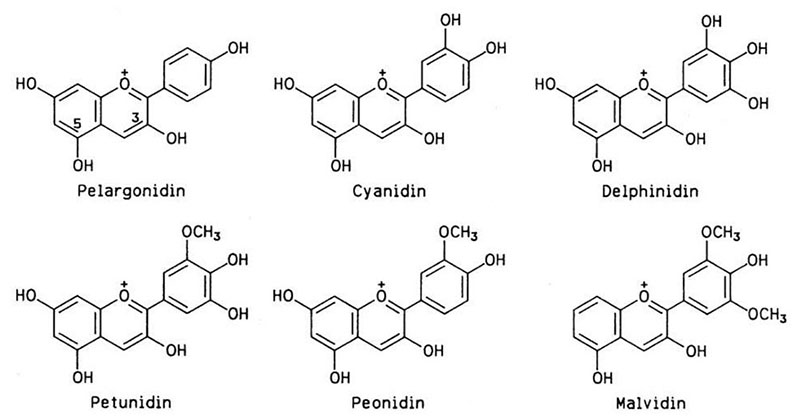
Wikipedia lists about 25 man-made chemicals that change color with pH (pH indicators). Here is the URL if you want to check it out:
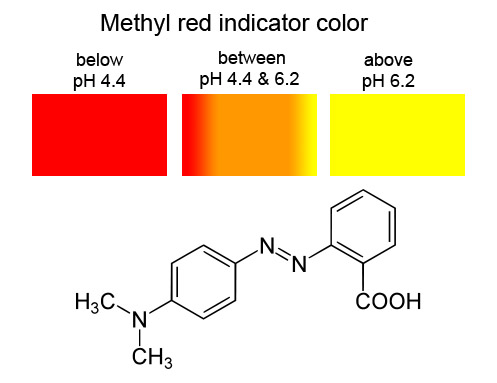
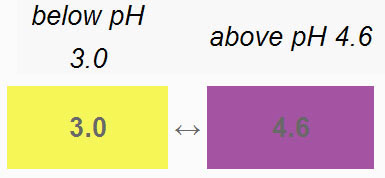
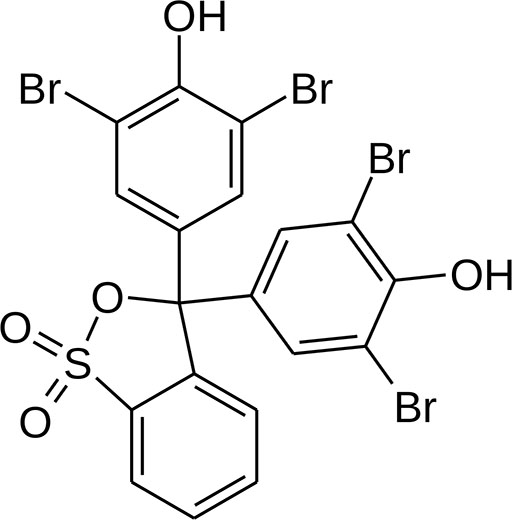
Bromophenol Blue: It was used in lab 7 to check the acidity of water that reacted with sulfur dioxide that came from burning sulfur. It caused the water to turn yellow which means the pH was at 3.0 or lower (more acidic). Notice in the image the yellow color at pH 3.0 or lower.
The name "phenol" refers to the rings that have an "OH" group on it. Phenol is a solvent that has one 6-carbon ring with a single OH group attached.
You may notice that like the pH indicators from plants, these man-made pH indicators also have 6-carbon rings that have double bonds alternating with single bonds. Visible light can cause these electrons to jump to higher energy levels, which means the color that causes that jump gets absorbed. So the reflected color is no longer white. For compounds that don't have these alternating double bonds, only high energy ultraviolet light can cause the electrons to jump to higher energy states. Visible light is not absorbed, so compounds without the alternating double bonds appear clear or white. Groups like OH, COOH, CO, and even nitrogen atoms are affected by H+ and OH- ions in solution because H+ and OH- ions may add or remove charges on the indicator molecule. Different charges on the molecule causes it to absorb different frequencies of light, so it changes color.
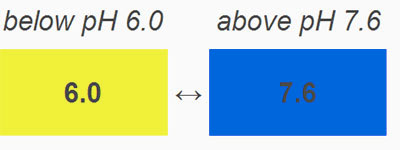
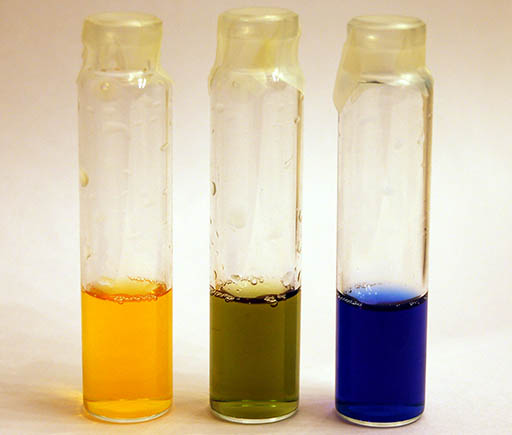

Bromothymol Blue molecular structure
Bromothymol Blue: This is the pH indicator you used for the on-campus lab to check water contaminated with pool acid or portland cement. Because it changes colors in slightly acidic to slightly alkaline solutions, it is used for situations that are checking pH places like swimming pools or fish tanks where the pH shouldn't vary too far from neutral pH (7).
Looking at the photo, notice that at pH 6.0 and below a solution with bromothymol is yellow. At a neutral pH it is green. At 7.6 and above it is blue. So it changes color over a rather narrow range of H+ concentration. In later lab we will show that the CO2 in your breath can change slightly alkaline water into acidic water.
Bromothymol blue is sometimes used prior to a birth to detect if the membrane surrounding the baby has broken. The amniotic fluid that surrounds the baby has a pH above 7.6. So it would turn the Bromothymol blue to a blue color.
The molecular structure of Bromothymol Blue is similar to bromophenol above except two bromine atoms were replaced with an isopropyl group (a carbon with two methyl (CH3) groups attached. Isopropyl groups look like "Y's" in the image.
"Thymol" is in the name "bromothymol" because thymol has a 6-carbon ring with bromine, OH, and isopropyl groups. As the name suggests, thymol comes from the spice called "thyme". Thymol, by the way, has antibacterial qualities.
The below image shows color changes even in the narrow range of pH 6.2 to 7.5. This image is in you lab manual.
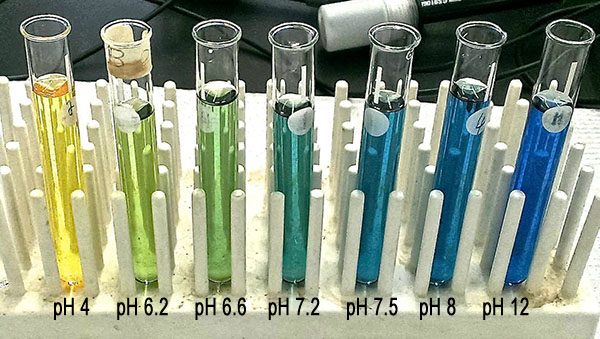
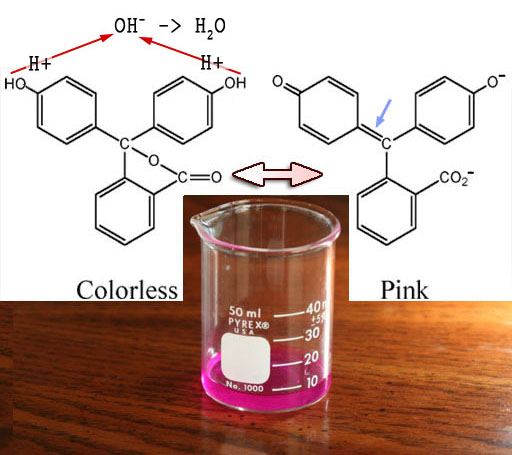
Phenolphthalein: This pH indicator will be used in the on-campus lab 5 to detect carbon dioxide. That makes the water alkaline. More details on how it works is in your lab manual under Lab 5: Global Warming.
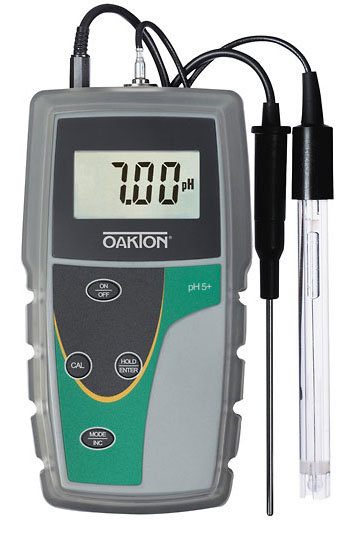
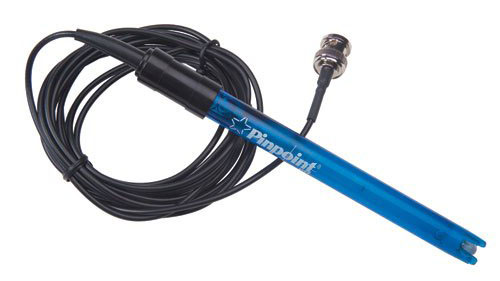
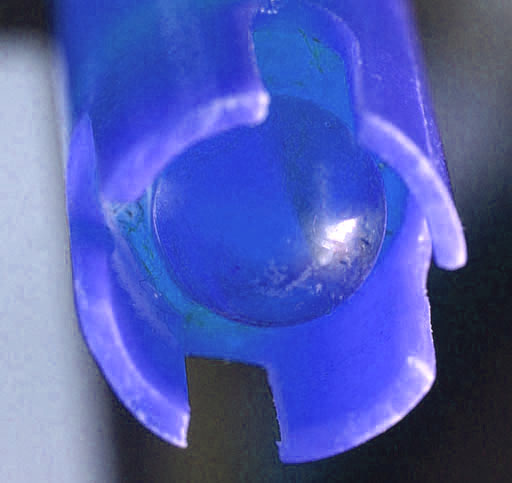

Below is a benchtop pH meter. Notice this is accurate to the thousandths place. By changing the probes, these meters can read the concentration of other ions other than just H+ ions.
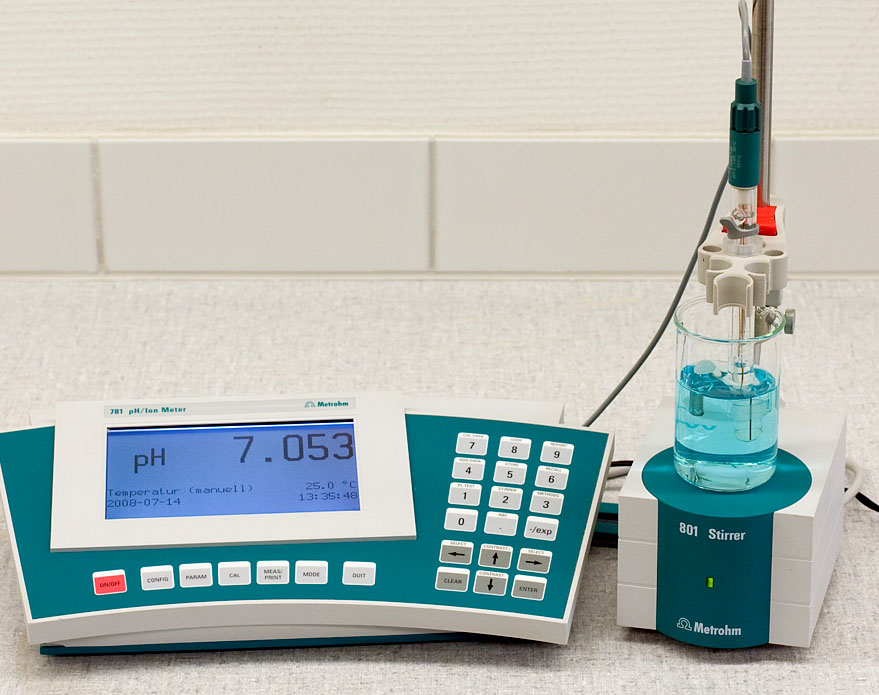
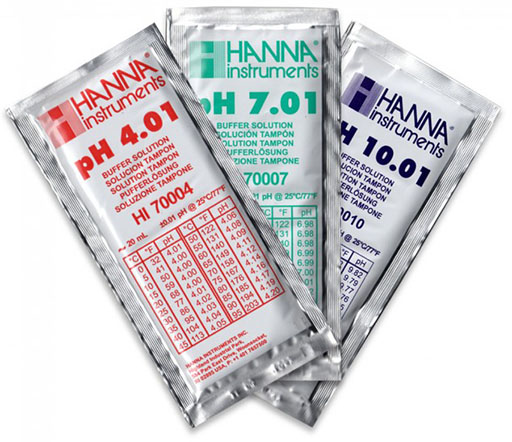

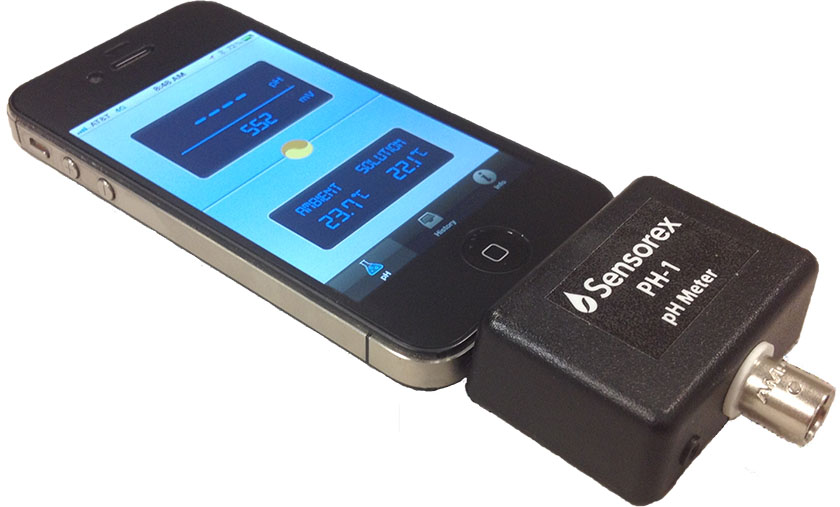
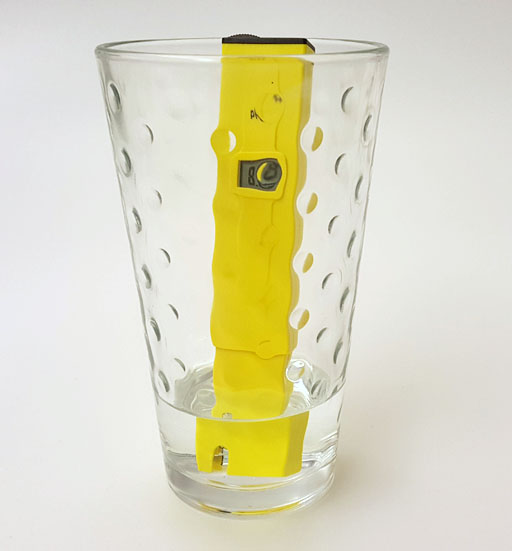
1) First measure the pH of your tap water.
2) Place about 1 inch of water into a cup or glass.
3)
Turn on pH meter and set it into the water.
B1)
Report the pH of the water.
Another way is to bring the water about an inch from the top of the class or cup and then dip the lower part of the pH meter into the water. Then read the pH value.


4) Now measure a beverage of your choice. Do it the same way as above.
B2) Report what the beverage was and its pH.
B3) Find the pH of more beverages as extra credit (up to three more).
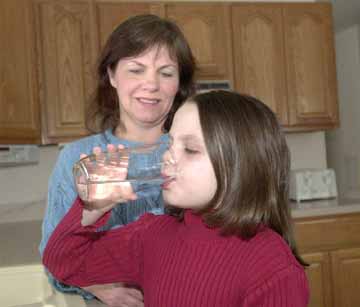
The water we use at home is probably one of the most important safety concerns we face. It's unfortunate, that polluted water can look the same as pure water. Cloudy or muddy water may just contain harmless sediment. (This image is from an article that talked about high levels of arsenic in a town's drinking water)
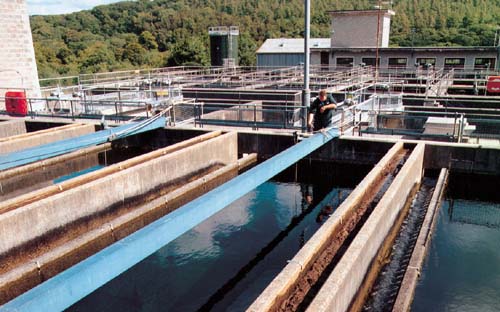
Chlorine: Even though people complain of a chlorine taste and are often buying filters to get rid of the chlorine, they forget that chlorine is there to prevent growth of bacteria. So having some chlorine in your tap water is good.
Chlorine is heavily used by water treatment plants to sterilize the water. Usually some chlorine stays in the water so that the antimicrobial benefits of chlorine is present in the water all the way to people's homes.

1) Take the chlorine
test strip and "swirl" it in the water 3 times. Swirling allows
it to contact more of the chlorine that may be in the water.
2)
Then take it
to the chart. Once you pull it out of the water, you are suppose to read
it at 10 seconds.
My water shows that it has very little chlorine in it.
I'd feel a little more comfortable if it had maybe 0.5 to 3 parts per million
(ppm) chlorine. Too much chlorine and it's irritating to the eyes and skin, plus will gradually bleach your hair..
C1) Report your best estimate of the chlorine level in your water. Be sure to include "ppm".

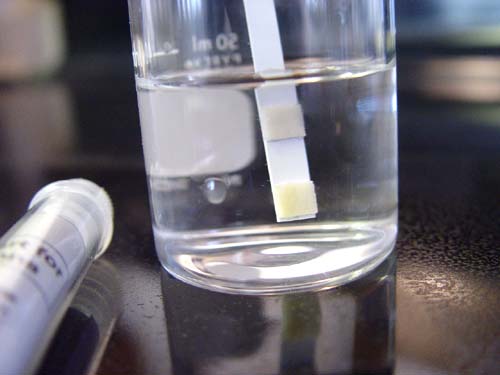

Since there are no pink or red colors on the test strips, I would say that thankfully my tap water has no nitrate or nitrite.
C2) Report your best estimate of the nitrate level in your water.
C3) Report your best estimate of the nitrite level in your water.


A hardness test is mostly measuring the amount of calcium in the water. An alkalinity test is measuring the amount of carbonate in the water. So both tests are targeting calcium carbonate; one measuring calcium and the other measuring the carbonate. So they both are very similar. In this lab we will just use the Hardness test (calcium test).
4) Take the hardness test paper and dip in tap water. Remove immediately and wait 15 seconds to read the value on the chart.
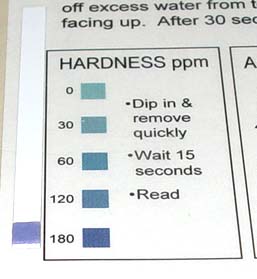
This is the result of the hardness test. The hue seems to match the 180 ppm, but the water makes it brighter. The hardness might be over 180 but we don't know because 180 is the highest level available for this particular test strip.
C4) Report the Hardness level of your tap water. If you are using a water softener, then it might be quite low because water softeners are supposed to remove the calcium ions and replace them with sodium ions.
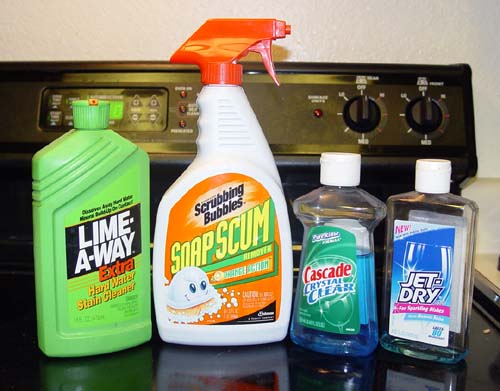

A water softener helps, but you still have the same amount of dissolved salts. The calcium gets replaced by sodium, which works better with soaps and doesn't form scale that is hard to wash away. The sodium, however, is not that healthy to drink.
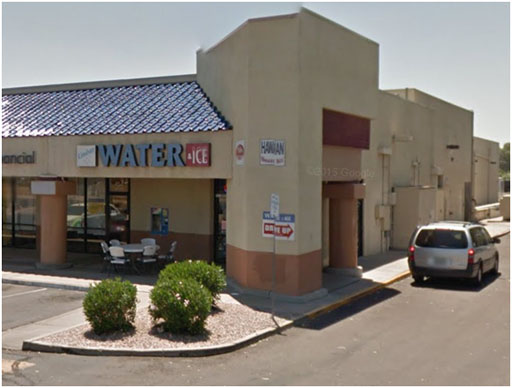
Test water from a coin-operated water dispenser or from a store that lets you buy water to fill up your jugs. This store in Mesa is where I like to go because they put up a sign that states the TDS level of their water.
D1) What is the TDS level of the water your purchased?
D2) What is the name and address of the store where you bought water.
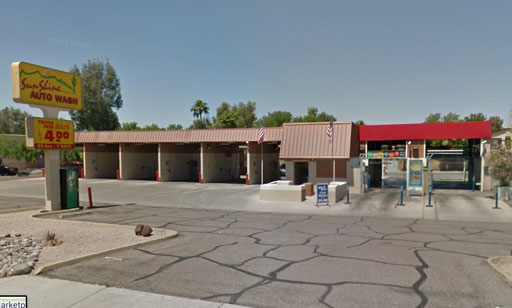
For extra credit, you can test the TDS level of "spot free" rinse water at a self-serve car wash. I like this car wash in Mesa because the equipment always works and the TDS level of the spot free rinse water was quite low (almost to distilled water levels). I had to bring a cup to spray the water into before dipping in the TDS meter. Note, this is not the high pressure rinse water, this is the spot-free low pressure rinse water.
D3) What is the TDS level of the spot free rinse water? (extra credit)
If you wish, you can copy the below summary into your email (or Word document) and type your answers after the descriptions. Be sure to title the email "Field Lab 3". Send email to chm107@chemistryland.com. Or you can send the data via Canvas.
A) Field Lab 3 Experiment: Finding TDS using a TDS meter
A1) Report the TDS value that you read off of your meter.
A2) Compare the reading you got with the readings in the below chart. What category does your tap water fall into?
A3) Report what beverage you used and its TDS level.
B) Field Lab 3 Experiment: Measuring the pH of Tap Water and Beverages
B1) Report the pH of the water.
B2) Report what the beverage was and its pH.
B3) Find the pH of more beverages as extra credit (up to three more).
C) Field Lab 3 Experiment: Using Test Strips for Chlorine, Hardness, Nitrate & Nitrite
C1) Report your best estimate of the chlorine level in your water. Be sure to include "ppm".
C2) Report your best estimate of the nitrate level in your water.
C3) Report your best estimate of the nitrite level in your water.
C4) Report the Hardness level of your tap water.
D) Field Lab 3 Experiment: Test TDS Level of water dispensers plus car wash
D1) What is the TDS level of the water your purchased?
D2) What is the name and address of the store where you bought water.
D3) What is the TDS level of the spot free rinse water? (extra credit)
Post-Lab questions and problems are on the Sapling Learning website. Those are graded automatically, so you will get your score on your Post-lab questions as soon as you finish them. http://www2.saplinglearning.com/
1. Once a solid is dissolved in water, is it still solid?
2. If sugar is dissolved in water, does it get measured using a TDS meter?